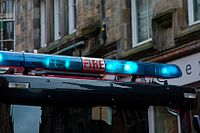American Samoa received eight minutes warning before 2009 tsunami
Friday, September 24, 2010
People in American Samoa were given only eight minutes warning that a tsunami, which killed 32 people in the unincorporated territory, resulting from the 2009 Samoa earthquake, was approaching. A report published by the United States Congress admits that the warning was issued sixteen minutes after the 8.0 magnitude earthquake struck Samoa. The tsunami killed nearly 200 people in American Samoa, Samoa and Tonga.
The report, written by the National Research Council, describes the length of time between the earthquake and the initial tsunami warning being issued as "relatively long", and states that the standard time for such a warning to be issued to be around two minutes. The study also revealed that one third of tsunami sensors are not working at any given time.
John Orcutt, a [seismologist and head of the committee that wrote the report, described the delay as a "major concern", but he also said that "a large number of people" in American Samoa "didn't understand and there were lives that were lost because people simply didn't take the action to get away from the shore when they felt this huge earthquake. People have to understand the signs of a tsunami and head to higher ground."
The Federal Emergency Management Agency, whose purpose is to coordinate the response to a disaster that has occurred in the United States and that overwhelms the resources of local and state authorities, and the Government of American Samoa did not respond to e-mails regarding the news.
Unprepared
The study also notes that people living in other coastal cities around the world are at risk of being unprepared for tsunamis that arrive soon after the earthquake occurs, stating that in many places, warnings might not be issued in time. "If the source were so close to shore that only minutes were available before the tsunami reached the coast, the public would need to recognize natural [signs of a tsunami approaching]." The report states that when they fear a tsunami is imminent, people should know to evacuate even "without official warnings."
The report warns that because tsunamis are so rare, people living near the coast do not know what to do, but it also criticises authorities for not informing citizens of how to react when a tsunami is approaching. "Everybody thought that the tsunami was a single wave, and once the expected landfall time came and left, they thought it was over," said Costas Synolakis, who is director of the Tsunami Research Center at the University of Southern California, and one of the report's authors. He continued, "In fact, tsunamis are a series of waves that can last for three to four hours."
He said that the United States must take action, training first responders in low-lying coastal areas, and adding more tsunami sensors to give advance warning of approaching waves. Synolakis added that, after receiving warning that there may have been a tsunami on the way after the Chile earthquake earlier this year, the response of firefighters at the Port of Los Angeles was poor because they were unfamiliar with how to deal with such a threat.
'All the people on the bus were screaming'
In the capital of American Samoa, Pago Pago, the tsunami measured 1.57 meters in height. The superintendent of the National Park of American Samoa Mike Reynolds reported four waves as high as six meters. People who experienced the quake said it was long, lasting from 90 seconds to three minutes. "Pago Pago city streets were strewn with overturned vehicles, cars, and debris. Some buildings located only slightly above sea level were completely destroyed by the waves, and power in some locations is not expected to be restored for up to a month," Wikinews reported at the time.
Didi Afuafi, 28, who was riding on a bus in American Samoa when the tsunami struck, described her experiences. "I was scared. I was shocked. All the people on the bus were screaming, crying and trying to call their homes. We couldn't get on cell phones. The phones just died on us. It was just crazy," she said. "This is going to be talked about for generations." U.S. President Barack Obama said of the disaster: "My deepest sympathies are with the families who lost loved ones and many people who have been affected by the earthquake and the tsunami."
The people of American Samoa will, next Wednesday, according to a press release by the government, "hold island-wide services to honor the memories of the 34 loved ones who lost their lives" during the tsunami. Church services will be held at 6:00 a.m., followed at 6:48 a.m.—the time when the earthquake occured—thirty-two bells will be rung in memory of those who perished.
Related news
- "Death toll from tsunami in Southeast Asia increases" — Wikinews, October 1, 2009
Sources
- "Tsunami Warning and Preparedness: An Assessment of the U.S. Tsunami Program and the Nation's Preparedness Efforts" — National Research Council,
- Chip Brian. "American Samoa Had 8 Minute Warning Before Last Year's Tsunami" — Mysmarttrend, 20 September 2010
- Goher Iqbal Punn. "American Samoa got eight minutes warning last year" — Buzztab, 20 September 2010
- Tony Barboza. "Better education about tsunamis for coastal residents is urged" — Los Angeles Times, 18 September 2010
- "Program American Samoa Government September 29 Memorial Service" — American Samoa Government, 21 September 2010


